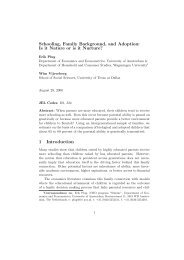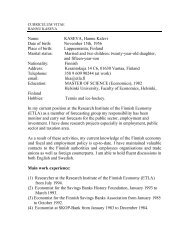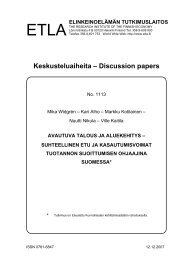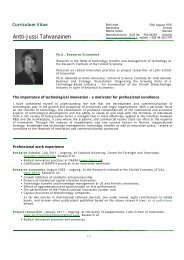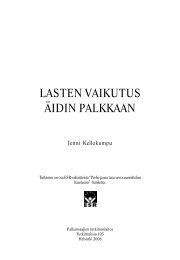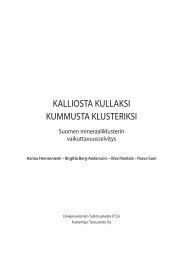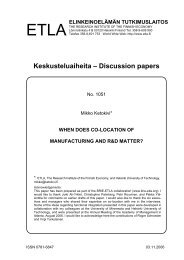Sergey Boltramovich, Grigory Dudarev, and Vladimir Gorelov ... - Etla
Sergey Boltramovich, Grigory Dudarev, and Vladimir Gorelov ... - Etla
Sergey Boltramovich, Grigory Dudarev, and Vladimir Gorelov ... - Etla
Create successful ePaper yourself
Turn your PDF publications into a flip-book with our unique Google optimized e-Paper software.
9<br />
John Holmes studying the Californian agglomeration went along theoretical<br />
lines of transaction cost theory. He rooted flexibility in the division of labour in<br />
production <strong>and</strong> linked that to agglomeration via analysis of the transaction costs<br />
associated with the interfirm linkages, i.e. traded exchange. This analysis is parallel<br />
to a major trend in business economics, i.e. that of network forms of production.<br />
The transaction cost theory is about the allocation through costminimization<br />
owing to its concentration on the traded input-output relationships.<br />
The evolutionary theory <strong>and</strong> knowledge based view in the strategic management<br />
open the way to underst<strong>and</strong>ing “untraded” interdependencies, which<br />
does not appear in recorded input-output transactions (Storper, 1997, Storper<br />
<strong>and</strong> Salais, 1992).<br />
Another significant challenge <strong>and</strong> difficulty in the present study was to assess<br />
the transition to the market economy <strong>and</strong> its impact on clusters <strong>and</strong> competitiveness.<br />
In this respect one shall mention the territorial-industrial complexes by<br />
Kolosovsky (1969) approach that included creation of both production facilities<br />
<strong>and</strong> a network of specialized higher educational establishments <strong>and</strong> R&D organizations<br />
in the certain region that was a central national <strong>and</strong> regional industrial<br />
policy <strong>and</strong> planning tool in the Soviet period. Implementation of this approach<br />
resulted in the major distortions in the production allocation decisions<br />
<strong>and</strong>, as a result of the on-going changes, the regional industrial l<strong>and</strong>scape is<br />
bound to change substantially in Russia. We believe that material presented in<br />
our study could shed some light on the processes of re-allocation in the Russian<br />
economy. We used also Porter diamond model to assess the regional competitiveness<br />
in Northwest Russia. Brown <strong>and</strong> Brown (1998) examined empirically<br />
the structure-conduct-performance paradigm in Russia <strong>and</strong> found supporting<br />
evidence. Therefore we believe that there is at least some evidence that one of<br />
the corner stones of the Porter approach, i.e. industrial organization approach is<br />
suitable to assess the period of transition.



